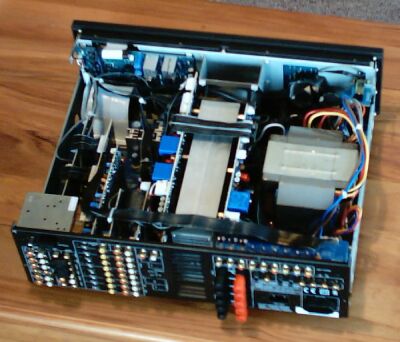

The heart of the audio side of the system is the A/V Receiver. I chose to go with the NAD T752 for a number of reasons. The first is that I had previously owned a NAD C320 integrated amp which I liked very much. NAD amplifiers feature well thought out design capable of exceeding it's power ratings into all channels simultaneously. As the speakers I was planning would have quite a bit of baffle step compensation, I needed good solid power, and the NAD T752 provides more than 80W into all 5 channels simultaneously - easily enough to drive the speakers to loud levels in our median sized lounge. Indeed, S&V magazine measured the T752's output as 92 Watts into 5 channels simultaneously before the onset of clipping. The T752 has all the features one would hope for and more. I am currently using it's 12V trigger outputs to switch the CD player on (when in CD mode only) and plan on using the Infrared input and outputs to incorporate all the IR receivers into one unit to avoid having to point our universal remote at the different units whilst performing macros etc.

Here is a picture of the cabinet I have the receiver in. Notice there is not much room around the receiver. Even during loud passages, however, I have not noticed the fan come on (ie it's not loud), nor have I had any heat problems or had the receiver go into protection mode. The cabinet is open at the back (I built it :) and I run all speakers set to SMALL with an 80Hz crossover frequency. Speakers (Designed and built by me - see the link to the left) are nominally 8ohm and impedance dips to around 5ohms.
As you can probably see, this page is far from finished. For now, check out the pictures I have taken before and after a processor upgrade
The software version of the NAD T752 can be discovered by pressing the VIDEO and AUDIO buttons on the front panel simultaneously.
 Original version of my store bought T752
Original version of my store bought T752
 Version after I performed a chip upgrade supplied by NAD
Version after I performed a chip upgrade supplied by NAD
After I performed the upgrade, my T752 needed resetting as the display was all funny (Filled with strange characters). This is done on non-US models by holding down VIDEO and TONE buttons simultaneously for 2 seconds or so. On US models use the VIDEO and TONE DEFEAT buttons. Upon releasing, the display should inform you of the reset. You'll likely need to turn the T752 off and then back on afterwards for the reset to be complete.
Here's some pictures I have taken of the T752 for those who are thinking of purchasing it and want to know what sort of connections it has, and what the amp section is like. Needless to say, it has pretty much all one needs...
 Back panel showing the inputs/outputs available in particular the IR and 12V trigger ins and outs
Back panel showing the inputs/outputs available in particular the IR and 12V trigger ins and outs
 Other half of the back panel showing the component video and digital inputs and outputs.
Other half of the back panel showing the component video and digital inputs and outputs.

 Internals of the T752 - check out that transformer!
Internals of the T752 - check out that transformer!
 Crystal CS4932 DSP chip
Crystal CS4932 DSP chip
 Cooling fan for blowing down the tunnel shaped extruded heatsink.
Cooling fan for blowing down the tunnel shaped extruded heatsink.
And here's some info you may want if you are thinking of upgrading your unit to the new software version by replacing the EEPROM chips. Your local NAD dealer will have the chips, and should do it for you. Just in case you want to know what's going to happen, here's some pictures...
 Tools needed to perform chip upgrade.
Tools needed to perform chip upgrade.



 Connectors to disconnect to remove front panel.
Connectors to disconnect to remove front panel.

 EEPROM microchips to replace.
EEPROM microchips to replace.
 Old chips removed from T752.
Old chips removed from T752.
What does the upgrade do? Basically it reduces the "volume tick" issue that earlier units had, and also improves the digital mute time which the processor uses while detecting the type of digital signal. It also adds features to the T752 that were built in to the T762, essentially making the software the same except for the second trigger out that the T762 has. Thus, renaming of inputs is now possible.
I'll be updating this page with a full review of the T752 as well as analysis of the bass management including frequency response graphs, and more info on the upgrades and any issues I have discovered. I hope this has been some help to you.
Hope you enjoy the site. For more info, contact me using the link to your left.